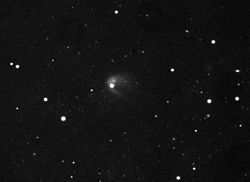- Main-belt comet
-
 Asteroid 596 Scheila displaying a comet-like appearance on December 12, 2010.
Asteroid 596 Scheila displaying a comet-like appearance on December 12, 2010.
Main-belt comets are bodies orbiting within the main asteroid belt which have shown cometary activity during part of their orbit. The Jet Propulsion Laboratory defines a main-belt asteroid as an asteroid with a semi-major axis (average distance from the Sun) of more than 2 AU but less than 3.2 AU, and a perihelion (closest approach distance to the Sun) of no less than 1.6 AU.[1]
Contents
Orbits
Unlike comets, which spend most of their orbit at Jupiter-like or greater distances from the Sun, main-belt comets follow near-circular orbits within the asteroid belt that are undistinguishable from the orbits of many standard asteroids. While quite a few short-period comets have semimajor axes well within Jupiter's orbit, main-belt comets differ in having small eccentricities and inclinations similar to main-belt asteroids. The first three identified main-belt comets all orbit within the outer part of the asteroid belt.[2]
It is not known how an outer Solar System body like the other comets could have made its way into a low-eccentricity orbit typical of the asteroid belt, which is only weakly perturbed by the planets. Hence it is assumed that unlike other comets, the main-belt comets are simply icy asteroids, which formed in an inner Solar System orbit close to their present positions, and that many outer asteroids may be icy.[2]
Activity
Some main-belt comets display a cometary dust tail only for a part of their orbit near perihelion. Activity in 133P/Elst–Pizarro is recurrent, having been observed at each of the last three perihelia.[3] The activity persists for a month or several[2] out of each 5-6 year orbit, and is presumably due to ice being uncovered by minor impacts in the last 100 to 1000 years.[2] These impacts are suspected to excavate these subsurface pockets of volatile material helping to expose them to solar radiation.[2]
When discovered in January 2010, P/2010 A2 (LINEAR) was initially given a cometary designation and considered a member of this group,[4] but P/2010 A2 is now believed to the remnant of an asteroid-on-asteroid impact.[5][6]. Observations of 596 Scheila indicated that large amounts of dust were kicked up by the impact of another asteroid of approximately 35 meters in diameter.
Composition
It has been hypothesized that main-belt comets may have been the source of Earth's water, since the deuterium-hydrogen ratio of the Earth's oceans is too low for classical comets to have been the principal source.[7]
Members
The term 'main-belt comet' is a classification based on orbit and the presence of an extended morphology. It does not imply that these objects are comets or that the material surrounding their nuclei was ejected by the sublimation of volatiles, as on comets.
Identified members of this morphology class include:
Full Name Hsieh[2] Jewitt[3] Semi-major axis (a) Perihelion (q) Perihelion date 133P/Elst–Pizarro Y Y 3.15 2.64 2013-Feb-08 176P/LINEAR Y Y 3.19 2.57 2011-Jul-02 238P/Read (P/2005 U1) Y Y 3.16 2.36 2011-Mar-10 P/2008 R1 (Garradd) Y Y 2.72 1.79 2013-Jan-25 P/2010 A2 (LINEAR) Y 2.29 2.00 2009-Dec-04 P/2010 R2 (La Sagra) Y 3.09 2.62 2010-Jun-25 596 Scheila Y Y 2.92 2.44 2012-May-19 See also
- Extinct comet
- Main-belt asteroid
- Centaur (minor planet)
References
- ^ "JPL "Main-belt Asteroid" Orbit Classification". JPL Solar System Dynamics. http://ssd.jpl.nasa.gov/sbdb_help.cgi?class=MBA. Retrieved 2010-12-15.
- ^ a b c d e f Henry H. Hsieh (May 2010). "Main Belt Comets". Hawaii. http://www.ifa.hawaii.edu/~hsieh/mbcs.shtml. Retrieved 2010-12-15. (older 2010 site)
- ^ a b David Jewitt. "Main Belt Comets". UCLA, Department of Earth and Space Sciences. http://www2.ess.ucla.edu/~jewitt/mbc.html. Retrieved 2010-12-15.
- ^ MPEC 2010-A51 : COMET P/2010 A2 (LINEAR)
- ^ Jewitt, David; Weaver, Harold; Agarwal, Jessica; Mutchler, Max; Drahus, Michal (2010). "A recent disruption of the main-belt asteroid P/2010?A2". Nature 467 (7317): 817. Bibcode 2010Natur.467..817J. doi:10.1038/nature09456.
- ^ Snodgrass, Colin; Tubiana, Cecilia; Vincent, Jean-Baptiste; Sierks, Holger; Hviid, Stubbe; Moissl, Richard; Boehnhardt, Hermann; Barbieri, Cesare et al. (2010). "A collision in 2009 as the origin of the debris trail of asteroid P/2010?A2". Nature 467 (7317): 814–6. doi:10.1038/nature09453. PMID 20944742.
- ^ Main-Belt Comets May Have Been Source Of Earths Water, Space Daily, Mar 23, (2006).
External links
- Henry Hsieh's Main-Belt Comets page has extensive details on Main-belt comets
- David Jewitt. Main Belt Comets
- Planetary Society article on MBCs
- Discussion of possible differences in characteristics of the water in MBCs and other comets
- YouTube Interview with David Jewitt (discussion on main-belt comets starts around 9 minutes into video)
- Impact trigger mechanism diagram by David Jewitt
- Comet-like appearance of (596) Scheila
- Project T3: Finding Comets in the Asteroid Population
Comets Features Nucleus · Coma · Tails · Antitail · Dust trail

Types Extinct · Lost · Great · Main-belt · Sungrazing (Kreutz Sungrazers) · Interstellar
Lists See also The Solar System  Categories:
Categories:- Comets
- Asteroids
- Main Belt asteroids
- Main Belt comets
Wikimedia Foundation. 2010.
